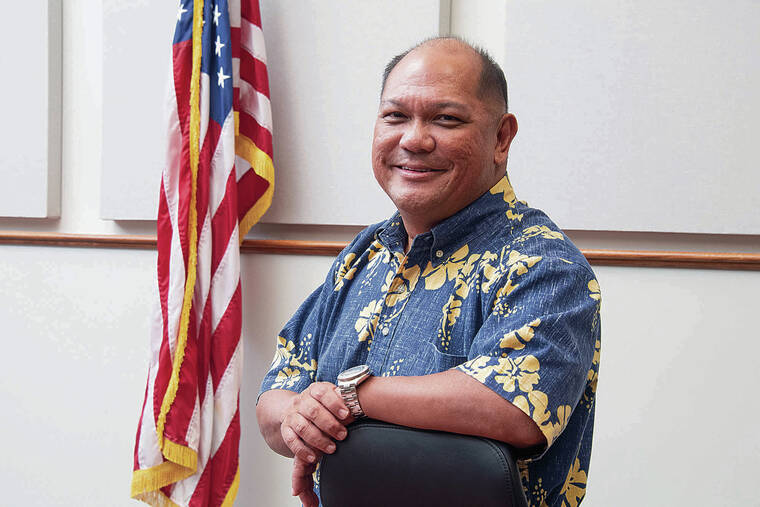Leo Asuncion Jr.: The Public Utilities Commission chair works to modernize agency while driving forward renewable-energy expansion plans

CRAIG T. KOJIMA / CKOJIMA@STARADVERTISER.COM
Environmental portrait of Leo Asuncion Jr., chairperson of the state Public Utilities Commission.
What are the PUC’s principal goals in the next few years?
I was a PUC commissioner for two years before being appointed the chair, so I plan to continue our goal of implementing our strategic plan, which largely centers around the modernization of our case management system. The new Case and Document Management System will modernize every aspect of our business processes. We’re hoping to launch this new system next spring.
One of my priorities is to improve our stakeholder engagement for all regulated entities. With my background in planning, I see the benefit of open communication and collaboration between different government agencies, community groups and the industry.
I also plan on updating our 2014 PUC Inclinations white paper, which offered the perspective of then-sitting commissioners on the vision, business strategies and regulatory policy changes needed to align utilities’ business models with customers’ interests and state public policy goals. The utilities and the state have progressed since the 2014 white paper, and we have new public policy goals.
While we have made great strides in modernizing our regulatory approach, we must continue to be forward-thinking and innovative to create a sustainable future with 100% renewable energy.
Hawaiian Electric has not yet developed enough green-energy generation to replace what the AES Hawaii coal plant provided. How can the commission balance the state’s renewable-energy goals against the business reality?
Don't miss out on what's happening!
Stay in touch with breaking news, as it happens, conveniently in your email inbox. It's FREE!
The PUC directed Hawaiian Electric (HECO) to bring online new renewable energy projects as quickly as possible, and we improved our internal processes to expedite the review of those new projects.
The PUC is starting to see developers restart their projects after sorting out the impacts of the pandemic and supply chain issues. For example, Hawaiian Electric’s newest utility-scale solar project, Mililani Solar developed by Clearway, recently came online and is providing 39 MW of power with 154 MWh of battery storage.
By the end of 2023, we anticipate another five projects on Oahu to come online with a combined total of 332.5 MW with over 1 GW of storage, providing an additional 4.6% toward our renewable energy portfolio compliance. In addition, another four projects on Oahu are scheduled to come online in 2024, and we are finalizing initiation of a new round of competitive bidding for Phase 3 renewable generation projects for Hawaiian Electric on Oahu, Maui, and Hawaii island.
In addition to building more renewables, our energy transition will also rely on our utility customers to take control of how they consume and produce energy.
Does the PUC have a role to play in encouraging the adoption of electric vehicles?
Hawaii is No. 2 in electric vehicles per capita. We got here because for more than a decade, the commission supported the expansion of EV adoption. In 2010, the commission approved HECO’s first-ever EV pilot rates. Today, there are special electricity rates for EVs to lower the cost of charging and accessible EV chargers throughout the state.
We’re also encouraging more EV charging stations by offering rebates to anyone who wants to install workplace or public charging stations. We also approved a pilot program for HECO to assist commercial customers in building out new electric infrastructure to support EV charging needs. While we have come a long way, there is still a lot of work that needs to be done to further integrate EVs into our renewable energy future, and we have encouraged HECO to take a leadership role in this area.
Noting the supply chain issues exposed by the pandemic, do you see Hawaii’s shipping industry operating optimally for the public? How could it be improved?
The PUC regulates Young Brothers, which provides shipping services between islands, but we understand that Hawaii’s shipping industry involves many other companies bringing goods from the mainland and other countries, which the PUC does not have jurisdiction over.
That said, we have and continue to monitor Young Brothers and other water carriers to encourage efficiencies in their operations to maintain reliable service and fair costs for our neighbor island residents who depend on intrastate shipping.
Can the impact of fuel costs on electricity rates be better managed? Could less of that burden be passed through to the ratepayer?
The PUC has long warned of leaving the cost of the renewable transition to world oil markets. Customer electricity bills fluctuate with the price of oil because purchased fuel costs are automatically passed down to customers with no markups on its cost. The PUC cannot simply mandate that the utilities stop charging this longstanding pass-through to customers.
To lessen our dependence on oil, the PUC encourages renewable projects that feature lower-cost fixed pricing and are expected to reduce costs compared to oil generation.
To realize these benefits, the PUC has directed Hawaiian Electric to bring online new renewable energy projects as quickly as possible to address our high energy costs and accelerate the transition to a renewable energy future.
Bonus question
Given the conflict over the Hu Honua Bioenergy project, how do you see Hawaii broadening its portfolio of energy sources?
For me, it is key that we keep a diverse portfolio of renewable energy resources to maintain system reliability and lessen the impact of any potential loss of any one source of energy.
That said, the state must also hone in on the specific types of renewable energy we want in our portfolio to meet the state’s renewable generation goals, keeping in mind customer costs and grid stability. Doing so sends an economic signal to the world and showcases what sustainability looks like in Hawaii.
THE BIO FILE
>> Title: Chairman, Hawaii Public Utilities Commission
>> Experience: State Office of Planning, Hawaiian Electric, SSFM International, Hawaii State Judiciary, state Land Use Commission
>> Education: Hawai‘i Pacific University (master’s in business administration); University of Hawaii (master’s in urban and regional planning, bachelor of arts); McKinley High School
>> Down time: An occasional round of golf; wine trips with friends; binge watching on Netflix; just relaxing at home.





